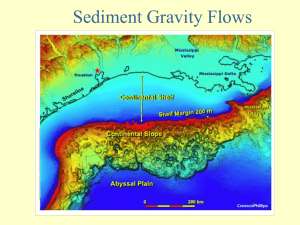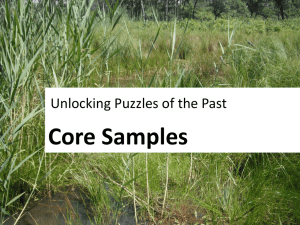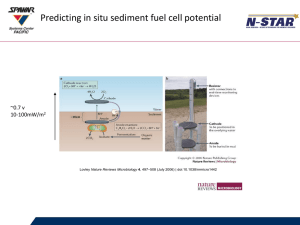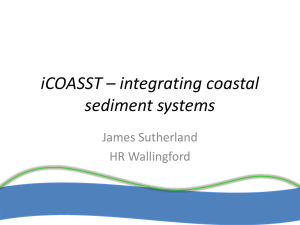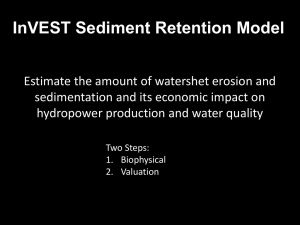research poster - University of North Carolina Wilmington
advertisement
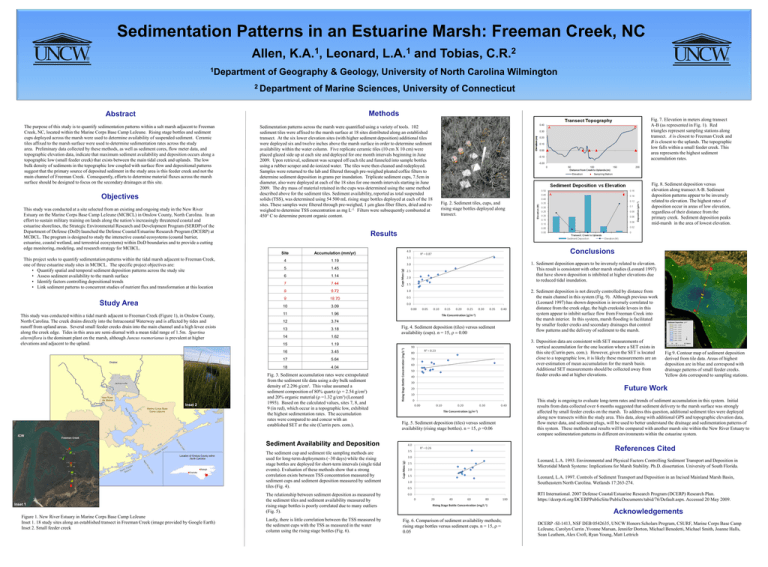
Sedimentation Patterns in an Estuarine Marsh: Freeman Creek, NC Allen, 1Department 1 K.A. , Leonard, and Tobias, 2 C.R. of Geography & Geology, University of North Carolina Wilmington 2 Department of Marine Sciences, University of Connecticut Methods Abstract The purpose of this study is to quantify sedimentation patterns within a salt marsh adjacent to Freeman Creek, NC, located within the Marine Corps Base Camp LeJeune. Rising stage bottles and sediment cups deployed across the marsh were used to determine availability of suspended sediment. Ceramic tiles affixed to the marsh surface were used to determine sedimentation rates across the study area. Preliminary data collected by these methods, as well as sediment cores, flow meter data, and topographic elevation data, indicate that maximum sediment availability and deposition occurs along a topographic low (small feeder creek) that exists between the main tidal creek and uplands. The low bulk density of sediments in the topographic low coupled with surface flow and depositional patterns suggest that the primary source of deposited sediment in the study area is this feeder creek and not the main channel of Freeman Creek. Consequently, efforts to determine material fluxes across the marsh surface should be designed to focus on the secondary drainages at this site. Objectives This study was conducted at a site selected from an existing and ongoing study in the New River Estuary on the Marine Corps Base Camp LeJeune (MCBCL) in Onslow County, North Carolina. In an effort to sustain military training on lands along the nation’s increasingly threatened coastal and estuarine shorelines, the Strategic Environmental Research and Development Program (SERDP) of the Department of Defense (DoD) launched the Defense Coastal/Estuarine Research Program (DCERP) at MCBCL. The program is designed to study the interactive coastal ecosystems (coastal barrier, estuarine, coastal wetland, and terrestrial ecosystems) within DoD boundaries and to provide a cutting edge monitoring, modeling, and research strategy for MCBCL. This project seeks to quantify sedimentation patterns within the tidal marsh adjacent to Freeman Creek, one of three estuarine study sites in MCBCL. The specific project objectives are: • Quantify spatial and temporal sediment deposition patterns across the study site • Assess sediment availability to the marsh surface • Identify factors controlling depositional trends • Link sediment patterns to concurrent studies of nutrient flux and transformation at this location Study Area This study was conducted within a tidal marsh adjacent to Freeman Creek (Figure 1), in Onslow County, North Carolina. The creek drains directly into the Intracoastal Waterway and is affected by tides and runoff from upland areas. Several small feeder creeks drain into the main channel and a high levee exists along the creek edge. Tides in this area are semi-diurnal with a mean tidal range of 1.5m. Spartina alterniflora is the dominant plant on the marsh, although Juncus roemerianus is prevalent at higher elevations and adjacent to the upland. Inset 2 ICW 1 L.A. Sedimentation patterns across the marsh were quantified using a variety of tools. 102 sediment tiles were affixed to the marsh surface at 18 sites distributed along an established transect. At the six lower elevation sites (with higher sediment deposition) additional tiles were deployed six and twelve inches above the marsh surface in order to determine sediment availability within the water column. Five replicate ceramic tiles (10 cm X 10 cm) were placed glazed side up at each site and deployed for one month intervals beginning in June 2009. Upon retrieval, sediment was scraped off each tile and funneled into sample bottles using a rubber scraper and de-ionized water. The tiles were then cleaned and redeployed. Samples were returned to the lab and filtered through pre-weighed pleated coffee filters to determine sediment deposition in grams per inundation. Triplicate sediment cups, 7.5cm in diameter, also were deployed at each of the 18 sites for one month intervals starting in June 2009. The dry mass of material retained in the cups was determined using the same method described above for the sediment tiles. Sediment availability, reported as total suspended solids (TSS), was determined using 54 500 mL rising stage bottles deployed at each of the 18 sites. These samples were filtered through pre-weighed, 1 mm glass fiber filters, dried and reweighed to determine TSS concentration as mg L-1. Filters were subsequently combusted at 450° C to determine percent organic content. Fig. 7. Elevation in meters along transect A-B (as represented in Fig. 1). Red triangles represent sampling stations along transect. A is closest to Freeman Creek and B is closest to the uplands. The topographic low falls within a small feeder creek. This area represents the highest sediment accumulation rates. Fig. 8. Sediment deposition versus elevation along transect A-B. Sediment deposition patterns appear to be inversely related to elevation. The highest rates of deposition occur in areas of low elevation, regardless of their distance from the primary creek. Sediment deposition peaks mid-marsh in the area of lowest elevation. Fig. 2. Sediment tiles, cups, and rising stage bottles deployed along transect. Results Site Accumulation (mm/yr) 4 1.19 5 1.45 6 1.14 7 7.44 8 9.72 9 18.70 10 3.09 11 1.96 12 3.74 13 3.18 14 1.62 15 1.19 16 3.45 17 5.64 18 4.04 Fig. 3. Sediment accumulation rates were extrapolated from the sediment tile data using a dry bulk sediment density of 2.296 g/cm³. This value assumed a sediment composition of 80% quartz (r = 2.54 g/cm³) and 20% organic material (r =1.32 g/cm³) (Leonard 1993). Based on the calculated values, sites 7, 8, and 9 (in red), which occur in a topographic low, exhibited the highest sedimentation rates. The accumulation rates were compared to and concur with an established SET at the site (Currin pers. com.). Conclusions 1. Sediment deposition appears to be inversely related to elevation. This result is consistent with other marsh studies (Leonard 1997) that have shown deposition is inhibited at higher elevations due to reduced tidal inundation. Fig. 4. Sediment deposition (tiles) versus sediment availability (cups). n = 15, r = 0.00 B 2. Sediment deposition is not directly controlled by distance from the main channel in this system (Fig. 9). Although previous work (Leonard 1997) has shown deposition is inversely correlated to distance from the creek edge, the high creekside levees in this system appear to inhibit surface flow from Freeman Creek into the marsh interior. In this system, marsh flooding is facilitated by smaller feeder creeks and secondary drainages that control flow patterns and the delivery of sediment to the marsh. 3. Deposition data are consistent with SET measurements of vertical accumulation for the one location where a SET exists in this site (Currin pers. com.). However, given the SET is located close to a topographic low, it is likely these measurements are an over-estimation of mean accumulation for the marsh basin. Additional SET measurements should be collected away from feeder creeks and at higher elevations. A g m-2 Fig 9. Contour map of sediment deposition derived from tile data. Areas of highest deposition are in blue and correspond with drainage patterns of small feeder creeks. Yellow dots correspond to sampling stations. Future Work Fig. 5. Sediment deposition (tiles) versus sediment availability (rising stage bottles). n = 15, r =0.06 This study is ongoing to evaluate long-term rates and trends of sediment accumulation in this system. Initial results from data collected over 6 months suggested that sediment delivery to the marsh surface was strongly affected by small feeder creeks on the marsh. To address this question, additional sediment tiles were deployed along new transects within the study area. This data, along with additional GPS and topographic elevation data, flow meter data, and sediment plugs, will be used to better understand the drainage and sedimentation patterns of this system. These methods and results will be compared with another marsh site within the New River Estuary to compare sedimentation patterns in different environments within the estuarine system. Freeman Creek AA B B Inset 1 Figure 1. New River Estuary in Marine Corps Base Camp LeJeune Inset 1. 18 study sites along an established transect in Freeman Creek (image provided by Google Earth) Inset 2. Small feeder creek Sediment Availability and Deposition References Cited The sediment cup and sediment tile sampling methods are used for long-term deployments (~30 days) while the rising stage bottles are deployed for short-term intervals (single tidal events). Evaluation of these methods show that a strong correlation exists between TSS concentration measured by sediment cups and sediment deposition measured by sediment tiles (Fig. 4). Leonard, L.A. 1993. Environmental and Physical Factors Controlling Sediment Transport and Deposition in Microtidal Marsh Systems: Implications for Marsh Stability. Ph.D. dissertation. University of South Florida. Leonard, L.A. 1997. Controls of Sediment Transport and Deposition in an Incised Mainland Marsh Basin, Southeastern North Carolina. Wetlands 17:263-274. RTI International. 2007 Defense Coastal/Estuarine Research Program (DCERP) Research Plan. https://dcerp.rti.org/DCERPPublicSite/PublicDocuments/tabid/76/Default.aspx. Accessed 20 May 2009. The relationship between sediment deposition as measured by the sediment tiles and sediment availability measured by rising stage bottles is poorly correlated due to many outliers (Fig. 5). Lastly, there is little correlation between the TSS measured by the sediment cups with the TSS as measured in the water column using the rising stage bottles (Fig. 6). Acknowledgements Fig. 6. Comparison of sediment availability methods; rising stage bottles versus sediment cups. n = 15, r = 0.05 DCERP -SI-1413, NSF DEB 0542635, UNCW Honors Scholars Program, CSURF, Marine Corps Base Camp LeJeune, Carolyn Currin ,Yvonne Marsan, Jennifer Dorton, Michael Benedetti, Michael Smith, Joanne Halls, Sean Leathem, Alex Croft, Ryan Young, Matt Lettrich


